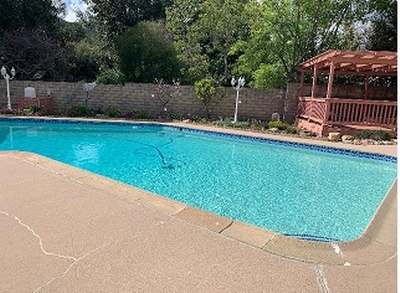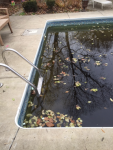A Swimming Pool Crack: Surface or Structural?
Swimming Pool Inspection Services (SPIS) received a request to inspect a swimming pool in Glendale, CA. The insured, Jason Cowley—the pool’s owner—claimed that there was a large crack in the bottom of his pool.
SPIS contacted Jason by phone. Jason explained that his in-ground pool was leaking, and he was refilling it about once per week. A couple of weeks ago, he noticed a large crack at the bottom of his pool, and he didn’t know how it got there.
Jason said he moved to the property over 40 years ago, and the swimming pool was already in place. He had it replastered 8-10 years earlier.
The SPIS pool inspector, Gerald Howe, inspected the pool. He reported that the freeform-shaped pool had a plaster interior finish over a gunite base. He noted that the pool’s tile was in normal condition for its age, but the coping, previously repaired, also showed some cracking as did the cement deck.
Mr. Howe performed leak detection tests, both on the pool’s plumbing and also on the pool’s structure.
Overall, the Cause of Loss (COL) was found to be age, wear, and tear.
A leak test on the pool’s plumbing showed that most of it was functioning properly, but the skimmer’s suction line showed some leaking. There was a section of pipe that was broken, caused by normal age, wear and tear. To repair it, the concrete would have to be opened around the skimmer and the dirt dug out under the skimmer to expose the suction line. The broken pipe would get replaced, the area would then be backfilled, and the concrete deck patched up.
Mr. Howe also performed a structural leak test. The underlying gunite structural layer was, of course, not visible, so the inspector added a colored dye to the pool water to test for leaking and to determine whether the crack was only in the surface plaster or if it went deeper. The quickness with which the dye was absorbed into the crack indicated that the crack extended through the plaster and into the underlying gunite. The dye also revealed other small cracks that were leaking. The accumulation of structural cracks in the pool was caused by age, wear, and tear—by settlement surrounding the pool. Over time, small settlement cracks got larger, with one of them eventually cracking the plaster surface and becoming visible to the owner. The inspector suggested that the company that did the replastering 8-10 years earlier could have missed settlement cracks that were already in the gunite—allowing them to grow larger.
To repair the cracks, the pool would have to be drained and the plaster removed. The structural cracks in the gunite would have to be filled and stapled, and the rebar structure assessed for any damage. Then the pool could be replastered.
Although the Cause of Loss was determined to be age, wear and tear; the homeowner may have good reason to blame the company that earlier replastered his pool for an increased expense in fixing subsequent cracking and leaking. More diligence in checking for small settlement cracks in the gunite understructure might have prevented later, larger cracks from developing. The cost of repairing small cracks in the gunite before plastering over them would be much less than the cost to again remove the plaster to fix larger, leaking cracks. And, the homeowner would not have been constantly refilling his pool and would not have suddenly discovered a mysterious crack in the bottom of his swimming pool.




Leave a Reply
Want to join the discussion?Feel free to contribute!